Ancient Egyptian Science and Technology
The characteristics of ancient Egyptians are indicated by a set of artifacts and customs that lasted for thousands of years. The Egyptians invented and used many basic machines, such as the ramp and the lever, to aid construction processes. They used rope trusses to stiffen the beam of ships. Egyptian paper, made from papyrus, and pottery was mass produced and exported throughout the Mediterranean basin. The wheel, however, did not arrive until foreign invaders introduced the chariot in the 16th century BC. The Egyptians also played an important role in developing Mediterranean maritime technology including ships and lighthouses.
Significant advances in ancient Egypt during the dynastic period include astronomy, mathematics, and medicine. Their geometry was a necessary outgrowth of surveying to preserve the layout and ownership of farmland, which was flooded annually by the Nile river. The 3,4,5 right triangle and other rules of thumb served to represent rectilinear structures, and the post and lintel architecture of Egypt. Egypt also was a center of alchemy research for much of the western world. Scenes depict scientists able to work in fields of alchemy, biology, chemistry, dentistry, anesthesiology, air flight, and more.
Did Ancient Egyptians Have Airplanes? Mechanical Engineer Thinks So Epoch Times - December 16, 2014
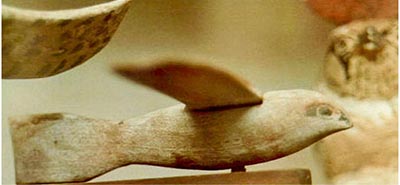
The pyramids and other advanced artifacts from ancient Egypt continue to awe archaeologists and archaeology enthusiasts, but is it possible the ancient Egyptians had aviation? A wooden carving dating from the 3rd century B.C. was found in a tomb in Sakkara (also spelled Saqqara), Egypt, in 1898. It was classified as a bird figure and placed with other bird carvings at the Cairo Museum, until Dr. Khalil Messiha, a medical doctor and Egyptologist, saw in it 1969 and realized it looked like the model airplanes he made as a child.
Dendera Light
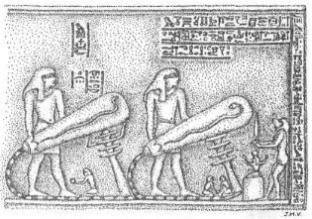
Electricity or Something Else?

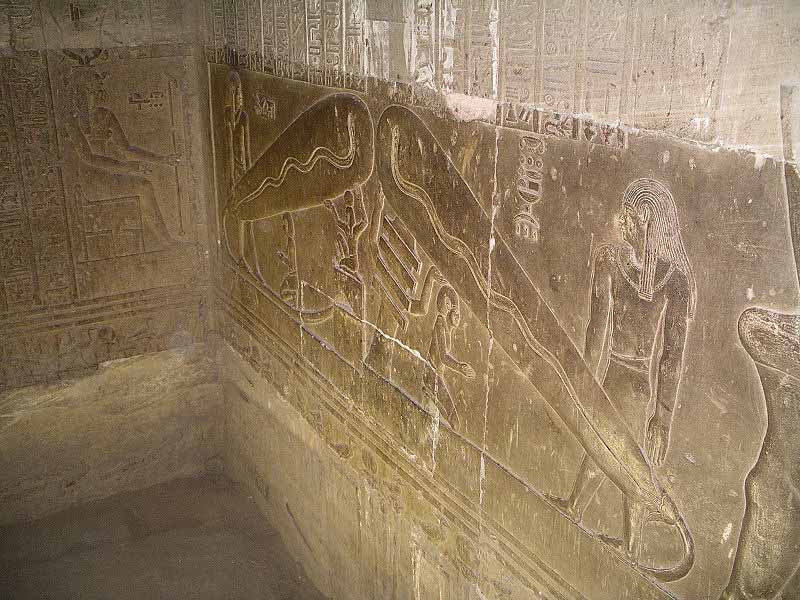
Some have suggested that the Egyptians had some form of understanding electric phenomena from observing lightning and interacting with electric fish (such as the Malapterurus electricus) or other animals (such as electric eels). The comment about lightning appears to come from a misunderstanding of a text referring to "high poles covered with copper plates" to argue this but Dr. Bolko Stern has written in detail explaining why the copper covered tops of poles (which were lower than the associated pylons) do not relate to electricity or lightning, pointing out that no evidence of anything used to manipulate electricity had been found in Egypt and that this was a magical and not a technical installation.
The single representation of the image, called the "Dendera light" by some alternative suggestions, exists on the left wall of the right wing in one of the crypts of the Hathor temple. Those exploring fringe theories of ancient technology have suggested that there were electric lights used in Ancient Egypt. Engineers have constructed a working model based on their interpretation of a relief found in the Hathor temple at the Dendera Temple complex.
The "Dendera light" is a technology of electrical lighting supposedly in existence in ancient Egypt, proposed by some fringe authors. Proponents argue that the technology is depicted in the Hathor temple at the Dendera Temple complex located in Egypt on three stone reliefs (one single and a double representation), which resemble some modern electical lighting systems. Egyptologists reject the theory and explain the reliefs as a typical set of symbolic images from Egyptian mythology.
Authors (such as Peter Krassa and Reinhard Habeck) have produced a basic theory of the device's operation. The standard explanation, however, for the Dendera light, which comprises three stone reliefs (one single and a double representation) is that the depicted image represents a lotus leaf and flower from which a sacred snake is spawned in accordance with Egyptian mythological beliefs. This sacred snake sometimes is identified as the Milky Way (the snake) in the night sky (the leaf, lotus, or "bulb") that became identified with Hathor because of her similar association in creation.

The cathode-ray tube or "Crookes' tube" like object depicted in scenes from the temple of Hathor at Dendera may depict a relativistic source of these heavy electrons - which
could drastically expedite the magical processes which involve these particular tubes.
The walls are decorated with human figures next to bulb-like objects reminiscent of oversized light bulbs.
Inside these "bulbs" there are snakes in wavy lines. The snakes' pointed tails issue from a lotus flower, which, without much imagination, can be interpreted as the socket of the bulb. Something similar to a wire leads to a small box on which the air god is kneeling. Adjacent to it stands a two-armed djed pillar as a symbol of power, which is connected to the snake. Also remarkable is the baboon-like demon holding two knives in his hands, which are interpreted as a protective and defensive power.
In his book The Eyes of the Sphinx, Erich Von Daniken writes that the relief is found in "a secret crypt" that "can be accessed only through a small opening. The room has a low ceiling. The air is stale and laced with the smell of dried urine from the guards who occasionally use it as a urinal." The room is not so secret, however, as many tourists visit and photograph the room every year. Von Daniken sees the snake as a filament, the djed pillar as an insulator, and claims "the monkey with the sharpened knives symbolizes the danger that awaits those who do not understand the device." This "device" is, the reader is assured, an ancient electric light bulb.
Ancient Egypt Illuminated by Electricity? Epoch Times - October 3, 2014
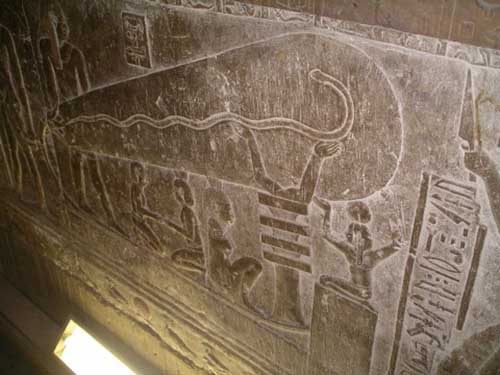
The light-bulb-like object engraved in a crypt under the Temple of Hathor in Egypt.
The most widely cited evidence that the ancient Egyptians used electricity is a relief beneath the Temple of Hathor at Dendera, Egypt that depicts figures standing around a large light-bulb-like object.
Metallurgy
Metallurgy was carried on with an elaborate technique and a business organization not unworthy of the modern world, while the systematic exploitation of mines was an important industry employing many thousands of workers. Even as early as 3400 B.C., at the beginning of the historical period, the Egyptians had an intimate knowledge of copper ores and of processes of extracting the metal. During the fourth and subsequent dynasties (i.e. from about 2900 B.C. onwards), metals seem to have been entirely monopolies of the Court, the management of the mines and quarries being entrusted to the highest officials and sometimes even to the sons of the Pharaoh.
Whether these exalted personages were themselves professional metallurgists we do not know, but we may at least surmise that the details of metallurgical practice, being of extreme importance to the Crown, were carefully guarded from the vulgar. And when we remember the close association between the Egyptian royal family and the priestly class we appreciate the probable truth of the tradition that chemistry first came to light in the laboratories of Egyptian priests.

Metal-Workers' Workshop in Old Egypt
Copper and Iron Extraction
In addition to copper, which was mined in the eastern desert between the Nile and the Red Sea, iron was known in Egypt from a very early period and came into general use about 800 B.C. According to Lucas, iron appears to have been an Asiatic discovery. It was certainly known in Asia Minor about I300 B.C. One of the Kings of the Hittites sent Rameses II, the celebrated Pharaoh of the Nineteenth Dynasty, an iron sword and a promise of a shipment of the same metal.
The Egyptians called iron 'the metal of heaven' or ba-en-pet, which indicates that the first specimen employed were of meteoric origin; the Babylonian name having the same meaning.
It was no doubt on account of its rarity that iron was prized so highly by the early Egyptians, while its celestial source would have its fascination. Strange to say, it was not used for decorative, religious or symbolical purposes, which - coupled with the fact that it rusts so readily - may explain why comparatively few iron objects of early dynastic age have been discovered.
One which has fortunately survived presents several points of interest: it is an iron tool from the masonry of the Great Pyramid of Khufu at Giza, and thus presumably dates from the time when the Pyramid was being built, i.e. about 2900 B.C. This tool was subjected to chemical analysis and was found to contain combined carbon, which suggests that it may have been composed of steel.
By 666 B.C. the process of casehardening was in use for the edges of iron tools, but the story that the Egyptians had some secret means of hardening copper and bronze that has since been lost is probably without foundation. Desch has shown that a hammered bronze, containing 10.34 per cent of tin, is considerably harder than copper and keeps a cutting edge much better.
Of the other non-precious metals, tin was used in the manufacture of bronze, and cobalt has been detected as a coloring agent in certain specimens of glass and glaze. Neither metal occurs naturally in Egypt, and it seems probable that supplies of ore were imported from Persia.
Lead, though it never found extensive application, was among the earliest metals known, specimen having been found in graves of pre-dynastic times. Galena (PbS) was mined in Egypt at Gebel Rasas ('Mountain of Lead'), a few miles from the Red Sea coast, and the supply must have been fairly good, for when the district was re-worked from 19I2 to 1915 it produced more than I8,000 tons of ore.
Gold
The vast quantities of gold amassed by the Pharaohs were the envy of contemporary and later sovereigns. Though much was imported, received by way of tribute, or captured in warfare, the Egyptian mines themselves were reasonably productive.
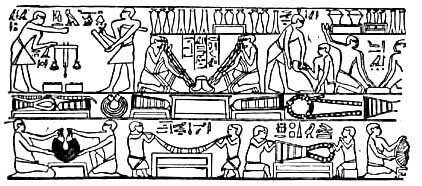
Egyptian Goldsmiths Washing, Melting and Weighing Gold Beni Hasan, 1900 B.C.
Over one hundred ancient gold workings have been discovered in Egypt and the Sudan, though within the limits of Egypt proper there appear to have been gold mines only in the desert valleys to the east of the Nile near Ikoptos, Ombos and Apollinopolis Magna.
Of one of these mines - possibly near Apollinopolis - a plan has been found in a papyrus of the fourteenth century B.C., and the remains of no fewer than 1,300 houses for gold-miners are still to be seen in the Wadi Fawakhir, halfway between Koptos and the Red Sea. In one of the treasure chambers of the temple of Rameses III, at Medinet-Habu, are represented eight large bags, seven of which contained gold and bear the following descriptive labels.
The Egyptian word for gold is nub, which survives in the name Nubia, a country that provided a great deal of the precious metal in ancient days. French Scientist Champollion regarded it as a kind of crucible, while Rossellini and Lepsius preferred to see in it a bag or cloth, with hanging ends, in which the grains of gold were washed - the radiating lines representing the streams of water that ran through.
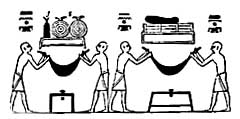
Gold Washing in Ancient Egypt
Crivelli has more recently advanced the theory that the gold symbol is the conventional sign for a portable furnace used for the fusion of gold, and that the rays represent the flames, which, 'as can be observed in the use of this type of furnace, are unable to ascend because the wind inclines them horizontally'.
In the later dynasties, the Egyptians themselves forgot the original significance of the sign and drew it as a necklace with pendent beads. Elliot Smith however says that this was the primitive form and became the determinative of Hathor, the Egyptian Aphrodite, who was the guardian of the Eastern valleys where gold was found.

Egyptian Goldsmith Workshop in the Pyramid Age
The gold mines in Nubia and other parts of the Egyptian empire seem to have been very efficiently designed and controlled, though with a callous disregard for the human element employed.
Alluvial auriferous sand was also treated, a distinction being made between the gold obtained in this way and that extracted from the mines. The latter was called nub-en-set, i.e. gold of the mountain, while alluvial gold was named nub-en-mu, i.e. 'gold of the river'. Auriferous sand was placed in a bag made of a fleece with the woolly side inwards; water was then added and the bag vigorously shaken by two men. When the water was poured off, the earthy particles were carried away, leaving the heavier particles of gold adhering to the fleece. There is a picture of this operation on one of the buildings at Thebes. buildings at Thebes.
Mercury
Mercury (Greek-hydra gyros, liquid silver; latin-argentum vivum, live or quick silver) is stated to have been found in Egyptian tombs of from 1500-1600 B.C.
Leyden Papyrus X
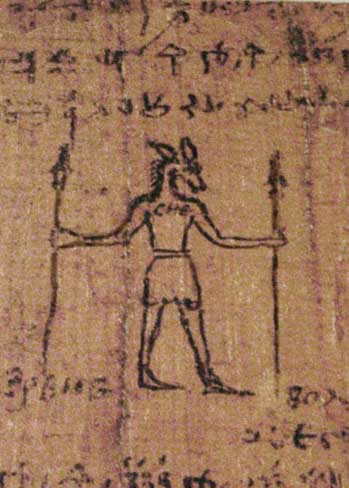
The Leyden papyrus X (P. Leyden X) is a papyrus codex written in Greek at about the end of the 3rd century A.D. or perhaps around 250 A.D. and buried with its owner, and today preserved at Leiden in the Netherlands. It contains alchemical texts, mostly concerned with making dyes and alloys which can be made to look like gold. It also mentions Moses as an alchemist.
The Leiden papyrus was discovered at Thebes in Egypt, together with the Stockholm Papyrus, which was probably written by the same scribe, and many Greek magical papyri, in the early 19th century by an adventurer calling himself Jean d'Anastasi, holding the office of Swedish vice-consul in Alexandria. In 1828 he sold a number of papyri to the Dutch government, which were lodged at the Leiden University Library, and labelled as "papyrus A", "papyrus B", etc. The first publication of information was in 1843, and the texts were published with Latin translation in 1885 by Leemans as Papyri Graeci Musei antiquarii publici Lugduni Batavii. Papyrus X is the most interesting of these. There is some relationship to the Greek magical papyri and to the Mappae clavicula.
The papyrus consists of 10 leaves, 30 x 34 cm in size, folded lengthwise and making 20 pages, of which 16 contain writing. Each page has 28-47 lines. The text contains one hundred and eleven recipes for extracting precious metals, or counterfeiting such metals, or precious stones and purple dye. It also contains details of the manufacture of textiles, and making gold and silver inks.
The recipes are not detailed, and probably served as an aide-memoire for those already familiar with the process. The presentation is exclusively practical, and does not include the usual alchemical or philosophical elements. The last eleven recipes are simply short extracts from the Materia Medica of Pedanius Dioscorides. They are chiefly descriptions of certain minerals. It is of interest to note that the extracts in the papyrus are very close to the present editions of this Greek writer compiled from quite different sources. The work is a collection of chemical recipes and directions for:
1. Making metallic alloys
2. Imitations of gold, silver or electrum
3. Dye and other related arts

Ancient Egyptian Medicine
Other Egyptian Papyri
Glass Making
Egyptian knowledge of glassmaking was advanced. The earliest known glass beads from Egypt were made during the New Kingdom around 1500 BC and were produced in a variety of colors. They were made by winding molten glass around a metal bar and were highly prized as a trading commodity, especially blue beads, which were believed to have magical powers.
The Egyptians made small jars and bottles using the core-formed method. Glass threads were wound around a bag of sand tied to a rod. The glass was continually reheated to fuse the threads together. The glass-covered sand bag was kept in motion until the required shape and thickness was achieved. The rod was allowed to cool, then finally the bag was punctured and the rod removed. The Egyptians also created the first colored glass rods which they used to create colorful beads and decorations. They also worked with cast glass, which was produced by pouring molten glass into a mold, much like iron and the more modern crucible steel.
The remains of glass furnaces discovered by Flinders-Petrie at Tel-El-Amarna (1400 B.C.) illustrates the manufacture of rods, beads, and jars or other figures, formed apparently by covering clay cores with glass and later removing the cores.
Egyptian glass articles were of colored glass, often beautifully patterned. Analyses of ancient Egyptian glass articles show that generally glass was a soda-lime glass with rather soda content as compared with modern soda-lime glass.
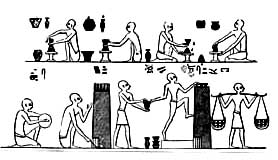
Egyptian Making Pottery, With Furnace Beni Hasan, 1900 B.C.
The given analyses do not differ from those of some soda-lime glasses of modern times. Lead was used in glasses from very ancient times. French scientist analyzed a vase of the Fourth dynasty in Egypt that contained about one quarter lead.
Artificial pearls, made of glass, were manufactured in such numbers that they formed an important article of export trade, and the old legends of enormous emeralds and other precious stones are most reasonably explained on the assumption that the preparation of paste jewelry was widely undertaken.
The earliest glass-works remains of which have been found date from the eighteenth dynasty, and the oldest dated glass object is a large ball bead bearing the cartouche of Amen-Hotep I, now in the Ashmolean Museum at Oxford. The invention of glass blowing, as opposed to the older method of glass-molding, is comparatively recent, dating back only to about the beginning of the Christian era. Sir Flinders Petrie has shown that the reliefs at Beni-Hassan, which were formerly supposed to represent glass blowers are more probably to be interpreted as metalworkers blowing a fire.
Paper and Writing
The word paper comes from the Greek term for the ancient Egyptian writing material called papyrus, which was formed from beaten strips of papyrus plants. Papyrus was produced as early as 3000 BC in Egypt, and sold to ancient Greece and Rome. The establishment of the Library of Alexandria limited the supply of papyrus for others. As a result, according to the Roman historian Pliny (Natural History records, xiii.21), parchment was invented under the patronage of Eumenes II of Pergamon to build his rival library at Pergamon.
Egyptian hieroglyphs, a phonetic writing system, served as the basis for the Phoenician alphabet from which later alphabets were derived. With this ability, writing and record keeping, the Egyptians developed one of the - if not the - first decimal system.
The city of Alexandria retained preeminence for its records and scrolls with its library. That ancient library was damaged by fire when it fell under Roman rule, and was destroyed completely by 642 CE. With it, a huge amount of antique literature, history, and knowledge was lost.
Structures and Construction
Buildings
Many temples from Ancient Egypt are still standing today. Some are in ruin from wear and tear, while others have been lost entirely. The Egyptian structures are among the largest constructions ever conceived and built by humans. They constitute one of the most potent and enduring symbols of Ancient Egyptian civilization. Temples and tombs built by a pharaoh famous for her projects, Hatshepsut, were massive and included many colossal statues of her.
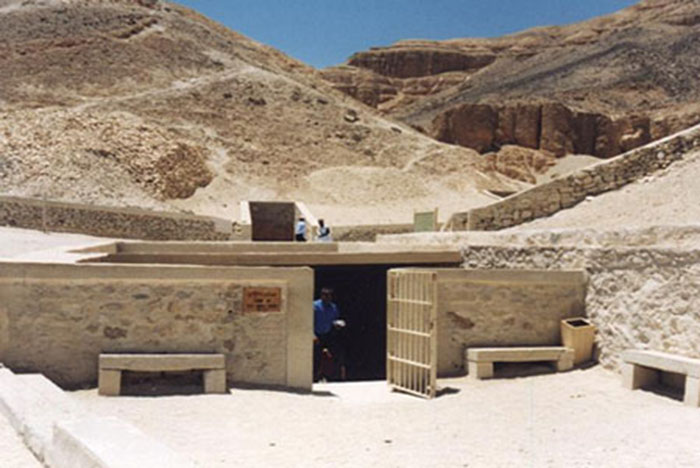
Pharaoh Tutankamun's rock-cut tomb in the Valley of the Kings was full of jewelery and antiques. In some late myths, Ptah was identified as the primordial mound and had called creation into being, he was considered the deity of craftsmen, and in particular, of stone-based crafts. Imhotep, who was included in the Egyptian pantheon, was the first documented engineer.
In Hellenistic Egypt, lighthouse technology was developed, the most famous example being the Lighthouse of Alexandria. Alexandria was a port for the ships that traded the goods manufactured in Egypt or imported into Egypt. A giant cantilevered hoist lifted cargo to and from ships. The lighthouse itself was designed by Sostratus of Cnidus and built in the 3rd century BC (between 285 and 247 BC) on the island of Pharos in Alexandria, Egypt, which has since become a peninsula. This lighthouse was renowned in its time and knowledge of it was never lost. A 2006 drawing of it created from the study of many references, is shown at the right.
Monuments
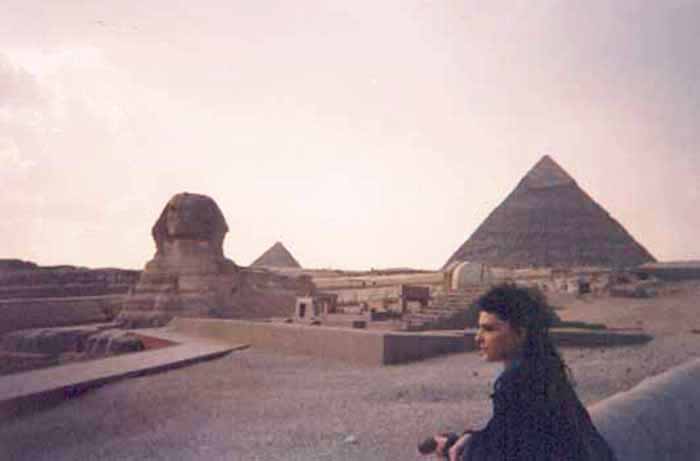
The Nile valley has been the site of one of the most influential civilizations in the world with its architectural monuments, which include the Pyramids of Giza and the Great Sphinx - among the largest and most famous buildings in the world. The most famous pyramids are the Egyptian pyramids - huge structures built of brick or stone, some of which are among the largest constructions by humans. Pyramids functioned as tombs for pharaohs.
In Ancient Egypt, a pyramid was referred to as mer, literally "place of ascendance." The Great Pyramid of Giza is the largest in Egypt and one of the largest in the world. The base is over 13 acres (53,000 m) in area. It is one of the Seven Wonders of the World, and the only one of the seven to survive into modern times. The Ancient Egyptians capped the peaks of their pyramids with gold and covered their faces with polished white limestone, although many of the stones used for the finishing purpose have fallen or been removed for use on other structures over the millennia.
The Red Pyramid of Egypt (c.26th century BC), named for the light crimson hue of its exposed granite surfaces, is the third largest of Egyptian pyramids. Menkaure's Pyramid, likely dating to the same era, was constructed of limestone and granite blocks. The Great Pyramid of Giza (c. 2580 BC) contains a huge granite sarcophagus fashioned of "Red Aswan Granite." The mostly ruined Black Pyramid dating from the reign of Amenemhat III once had a polished granite pyramidion or capstone, now on display in the main hall of the Egyptian Museum in Cairo . Other uses in Ancient Egypt, include columns, door lintels, sills, jambs, and wall and floor veneer.
The ancient Egyptians had some of the first monumental stone building. How the Egyptians worked the solid granite is still a matter of debate. Dr. Patrick Hunt has postulated that the Egyptians used emery shown to have higher hardness on the Mohs scale. Regarding construction, of the various methods possibly used by builders, the lever moved and uplifted obelisks weighing more than 100 tons.
Obelisks
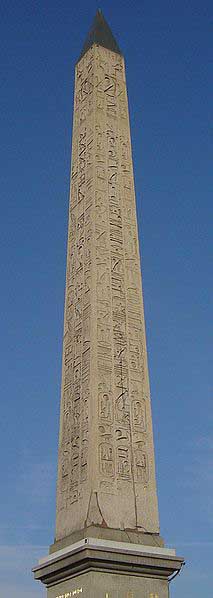
Obelisks were a prominent part of the architecture of the ancient Egyptians, who placed them in pairs at the entrances of various monuments and important buildings, such as temples. In 1902, Encyclopedia Britannia wrote, "The earliest temple obelisk still in position is that of Senwosri I of the Twelfth Dynasty at Heliopolis (68 feet high)".
The word "obelisk" is of Greek rather than Egyptian origin because Herodotus, the great traveler, was the first writer to describe the objects. Twenty-nine ancient Egyptian obelisks are known to have survived, plus the unfinished obelisk being built by Hatshepsut to celebrate her sixteenth year as pharaoh. It broke while being carved out of the quarry and was abandoned when another one was begun to replace it.
The broken one was found at Aswan and provides the only insight into the methods of how they were hewn. The obelisk symbolized the sky deity Ra and during the brief religious reformation of Akhenaten, was said to be a petrified ray of the Aten, the sun disk. It is hypothesized by New York University Egyptologist Patricia Blackwell Gary and Astronomy senior editor Richard Talcott that the shapes of the ancient Egyptian pyramid and Obelisk were derived from natural phenomena associated with the sun (the sun-god Ra being the Egyptians' greatest deity). It was also thought that the deity existed within the structure. The Egyptians also used pillars extensively.
It is unknown whether the Ancient Egyptians had kites, but a team led by Maureen Clemmons and Mory Gharib raised a 5,900-pound, 15-foot (4.6 m) obelisk into vertical position with a kite, a system of pulleys, and a support frame. Maureen Clemmons developed the idea that the ancient Egyptians used kites for work. Ramps have been reported as being widely used in Ancient Egypt.
A ramp is inclined plane, or a plane surface set at an angle (other than a right angle) against a horizontal surface. The inclined plane permits one to overcome a large resistance by applying a relatively small force through a longer distance than the load is to be raised. In civil engineering the slope (ratio of rise/run) is often referred to as a grade or gradient. An inclined plane is one of the commonly-recognized simple machines. Maureen Clemmons subsequently lead a team of researchers demonstrating a kite made of natural material and reinforced with shellac (which according to their research pulled with 97% the efficiency of nylon), in a 9mph wind, would easily pull an average 2-ton pyramid stone up the 1st two courses of a pyramid (in collaboration with Cal Poly, Pomona, on a 53-stone pyramid built in Rosamond, CA).
Ancient Egyptians had experience with building a variety of ships. Some of them survive to this day as Khufu Solar ship. The ships were found in many areas of Egypt as the Abydos boats and remnants of other ships were found near the pyramids.
Sneferu's ancient cedar wood ship Praise of the Two Lands is the first reference recorded to a ship being referred to by name.
Although quarter rudders were the norm in Nile navigation, the Egyptians were the first to use also stern-mounted rudders.
Navigation and Ship Building
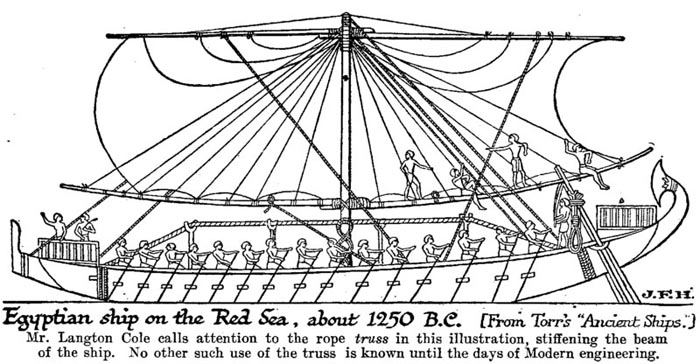
The Ancient Egyptians had knowledge to some extent of sail construction. This is governed by the science of aerodynamics. The earliest Egyptian sails were simply placed to catch the wind and push a vessel. Later Egyptian sails dating to 2400 BCE were built with the recognition that ships could sail against the wind using the side wind. Queen Hatshepsut oversaw the preparations and funding of an expedition of five ships, each measuring seventy feet long, and with several sails. Various others exist, also.
Irrigation and Agriculture
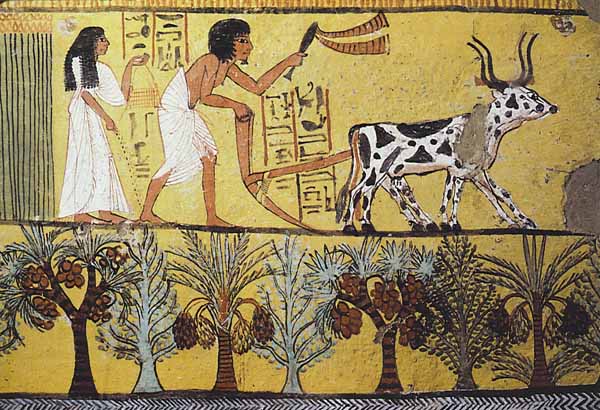
Irrigation as the artificial application of water to the soil was used to some extent in Ancient Egypt, a hydraulic civilization (which entail hydraulic engineering). In crop production it is mainly used to replace missing rainfall in periods of drought, as opposed to reliance on direct rainfall (referred to as dryland farming or as rainfed farming).
There is evidence of the ancient Egyptian pharaoh Amenemhet III in the twelfth dynasty (about 1800 BCE) using the natural lake of the Fayum as a reservoir to store surpluses of water for use during the dry seasons, as the lake swelled annually as caused by the annual flooding of the Nile.

To lift the water from the canal they used a shaduf. A shaduf is a large pole balanced on a crossbeam, a rope and bucket on one end and a heavy counter weight at the other. By pulling the rope it lowered the bucket into the canal. The farmer then raised the bucket of water by pulling down on the weight. He then swung the pole around and emptied the bucket onto the field.

Animals were very important to Egyptian farmers. Animals helped them with jobs like trampling in the seeds, pulling the plough, eating unwanted grain or wheat and providing the Egyptians with food and drink. They kept animals such as cattle, goats, pigs, ducks, cows, and geese.
Plant Medicine

Furniture
The Egyptians developed a variety of furniture. There in the lands of ancient Egypt is the first evidence for stools, beds, and tables (such as from the tombs similar to Tutenkhamen's). Recovered Ancient Egyptian furniture includes a third millennium BC. bed discovered in the Tarkhan Tomb, a c.2550 BC. gilded set from the tomb of Queen Hetepheres, and a c. 1550 BC. stool from Thebes.
Use of Ropes
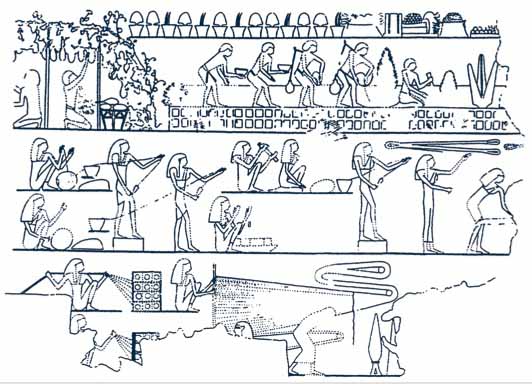
Ancient Egyptian depiction of women engaged in mechanical rope making, the first graphic evidence of the craft, shown in the two lower rows of the illustration.
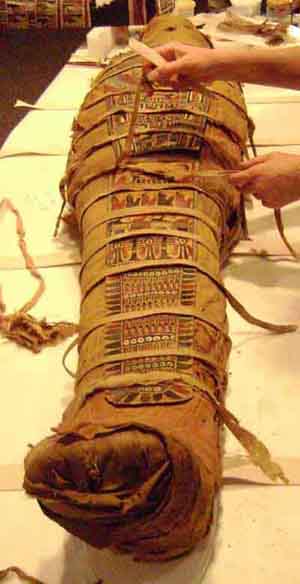
Mummification

Alchemy
EGYPT INDEX
ANCIENT CIVILIZATIONS
ALPHABETICAL INDEX
CRYSTALINKS HOME PAGE
PSYCHIC READING WITH ELLIE
BOOK: THE ALCHEMY OF TIME
DONATION TO CRYSTALINKS
ADVERTISE ON CRYSTALINKS























